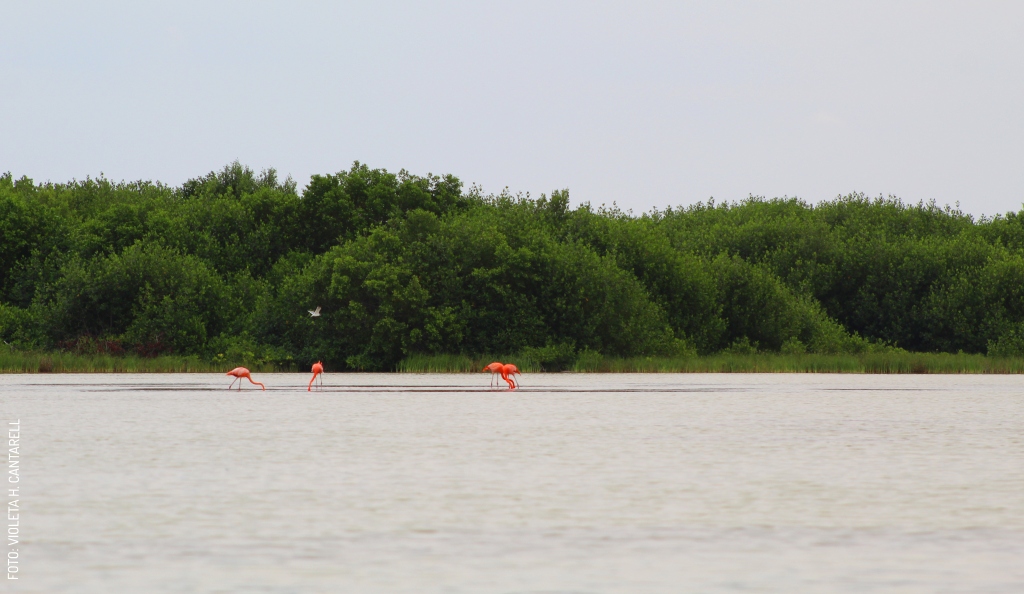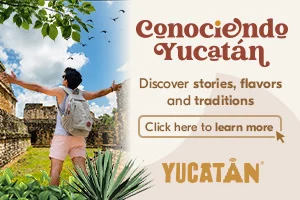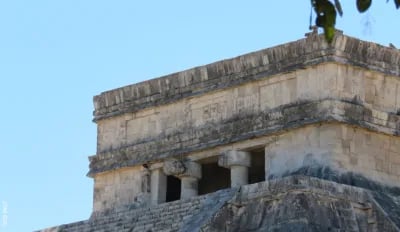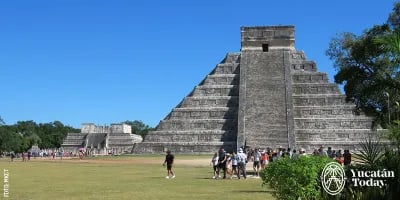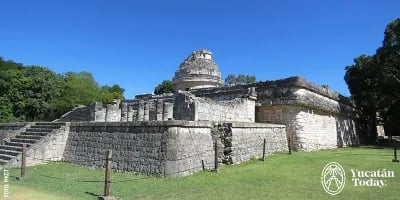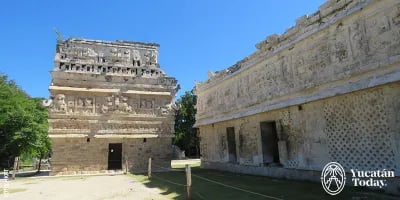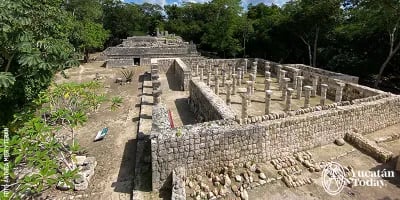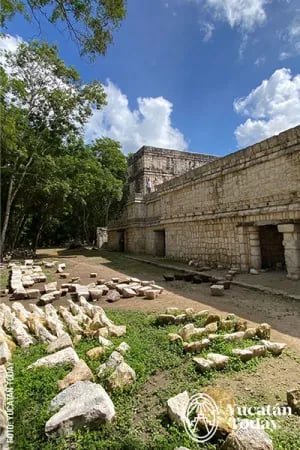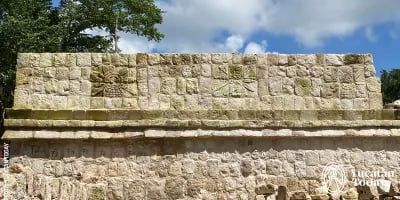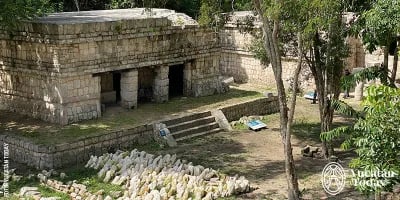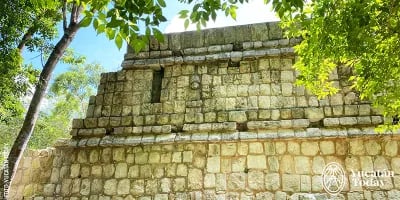- Home
- Destinations
- Chichen Itzá
Chichén Itzá
We tend to think about archaeological sites as static places: cities that are discovered, uncovered, shown to the general public, and preserved for future generations.
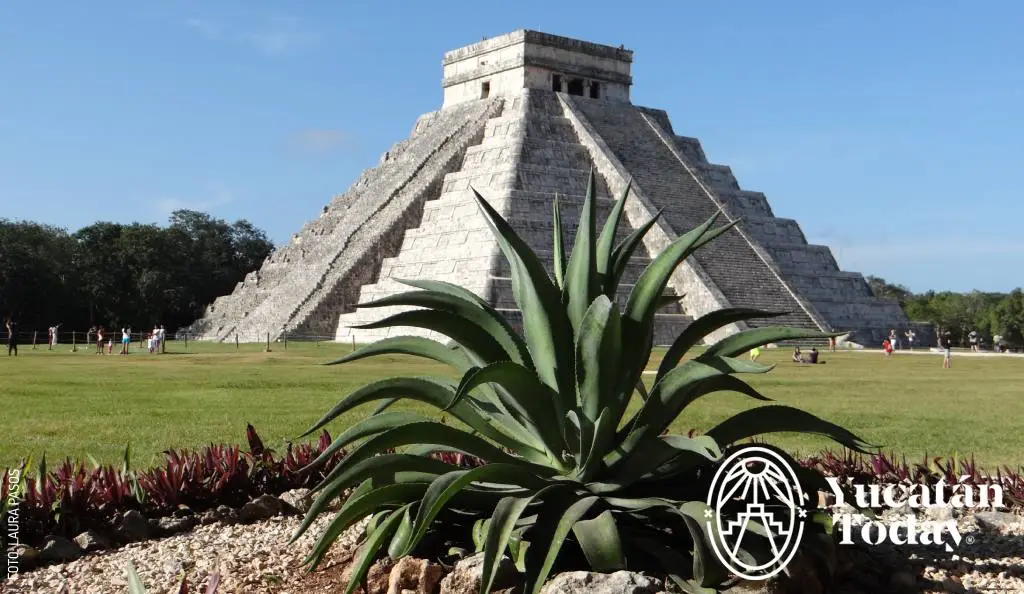
.webp?width=378&height=219&name=1601-Chichen-Itza-Piramide-de-Kukulkan-by-Laura-Pasos%20(1).webp)
However, in México, at least, archaeological sites are places that are in constant evolution, thanks to the work (and huge effort) carried out by large teams with varied backgrounds, skills, and knowledge. Archaeologists, yes, but also restoration experts, architects, field illustrators, photographers, construction workers, engineers, and many other people who tirelessly work “behind the scenes” to unveil part of the lost splendor of the past.
Each of those people and the work they do deserves a separate article (and at Yucatán Today we’re definitely looking forward to getting those to you), but for now we’ll focus on the object of their work; specifically, in the iconic, ever-crowded Maya site of Chichén Itzá. Let’s start with some perspective.
México and its relationship with archaeology
Archaeology originally begins as an exploration and interpretation of what is believed to be the “strangeness” discovered in European colonies. This is a broad generalization, mind you, but we could say that, especially in the 19th century, the line between being an archaeologist and a treasure hunter was very thin, and looting was justified under the pretense of filling out museums that were (also broadly speaking) an exhibition of those weird, primitive freak shows found beyond the civilized world (i.e., Europe).
We should keep in mind that, since the “discovery” of the Americas in 1492, Europeans had believed that they were dealing with ignorant, inferior peoples. Unable to understand how sophisticated they actually were, they deemed their knowledge worthless, and went on to destroy it.
Archaeology in colonized countries (in Latin America, Asia, and Africa), as such, becomes a very different animal. It isn’t about studying those strange “others”, but about studying ourselves; about rediscovering the roots of the practices and beliefs we hold today, and to reclaim our place, not as inferiors, but as peers who were unfairly treated and represented in the history that others wrote about us.
In México, archaeological sites are a fundamental part of the nation’s social heritage: they’re meant to be the collective cultural assets that every citizen should have a claim and access to, regardless of their social, economic, or cultural situation. Archaeology, on the other hand, becomes not only about the objects of the past, but also about the people who conceived and built them, in order to interpret and understand the history that conquerors and colonizers tried to erase.
México is home to 80% of the archaeological discoveries made in the Americas, and one of the few countries in the world whose legislation mandates a percentage of its gross domestic product be destined to conserving its historical heritage. In México there are over 53,000 known sites, though only 193 of those are open to the public. Of those, 17 can be found in Yucatán, and not one of them attracts more visitors than Chichén Itzá. It’s actually what Chichén Itzá brings in revenue that helps maintain, research, and explore other sites.
What’s so special about Chichén Itzá? How long does it take to visit?
Other than sombreros, there is nothing more widely associated with México than the Castillo or Kukulkán pyramid in Chichén Itzá. Thousands of visitors from all over the world arrive every day to take pictures with this structure, and look around the surrounding ones while they’re there. If you’re coming with a tour group, your itinerary will include a guided stroll of the central area that will take about an hour, an hour and a half at most: just enough time to take some pictures with the pyramid and for your guide to make you clap and yell “tequila” to show you the acoustic phenomenon that allowed the Chichén lords give speeches that everyone in attendance could hear. Then you’ll get about a half hour to shop for souvenirs, and that’s it: on to what’s next.
But there’s so much more to see, understand, and take in in Chichén Itzá for those willing to do it (and willing to endure the jarring cacophony of massive groups and handcraft vendors). First of all, consider that you’ll need to walk at least three kilometers (about two miles) if you want to see the whole site, not including the Sacred Cenote; if you want to see that one for yourself, that’s roughly another kilometer (a little over half a mile). If you add the Initial Series in Chichén Viejo, that’s another two miles.
In other words, if you really want to make the most to your visit to Chichén Itzá and marvel at everything it has to offer, you need significantly more than one hour.
How to prepare your visit to Chichén Itzá
Keep in mind that you may not be aware of just how hot it gets at archaeological sites in Yucatán. On a cool mid-fall day, at 10 am, we’ve seen international visitors drenching their clothes in cold water to protect themselves from heatstroke. As such, it’s a good idea to get there as early as possible and plan for at least a couple of breaks where you can cool off under the shade of a tree.
Today’s Tips
- The entire area around the Castillo and the Sacbés (pre-Hispanic walkways) that lead to the other areas are usually crowded with handcraft vendors and booths, which visitors usually find unpleasantly surprising.
- The further you are from the central area (closer to the Cenote Sagrado, the Observatory, and the Nunnery group), the amount of vendors (and the noise level) goes down.
- Vendors, just like visitors, are allowed inside Chichén Itzá and begin to set up shop at 8 am. The earlier you can be there, the more likely you are to enjoy some peace when you first get there.
- Make sure to wear cool, breathable clothes and comfortable walking shoes, preferably closed. You’ll need a hat (if you choose a baseball hat, don’t forget your neck and ears will be exposed to the sun), lots of sunscreen, insect repellent, and enough cool drinking water. A hand fan or an umbrella will never be a bad decision.
- Between May and September, the rainy season in Yucatán, a portable raincoat might come in very handy.
Accessibility in Chichén Itzá
Part of the site is wheelchair accessible. If you have a service dog, you’ll need to show proper documentation.
A quick look at the history of Chichén Itzá
Up until somewhat recently, it was believed that Chichén Itzá had been founded in the 10th century, making it a fairly new city, as far as the Maya world is concerned. Findings in Chichén Viejo tell us about a much earlier settlement of the area, as well as about its later downfall.
As far as we know now, Chichén Itzá was founded in the 7th century as a small settlement that grew to become a large capital in the 10th and 11th centuries, whose buildings were reused and enlarged at different stages. The city of Chichén Itzá would have been founded by members of the Cupul lineage coming from Ek Balam. While originally they were believed to be Itzá, now it is believed that Itzá was not a lineage, but a government position given to certain people.
We do know that the ruling class in Chichén Itzá, unlike in the cities that came before it through the Maya Classical period (around 800 CE) comprised several families and lineages that rotated in positions and responsibilities, and that, due to ongoing conflicts or rivalries with other lineages around them, they chose to look for strategic partners in what is now central México. This gave way to a wider “foreign” influence, evident in several ways; for example, traditional Maya glyph writing fell out of use to give way to a more pictographic writing system that new allies could more easily understand.
Plan your visit
Arrival and admission
If you’re going by public transport, go to Pisté and take a taxi to Chichén Itzá from there (it’s 2.6 km or 1.6 mi away). Whether that way of by car on your own, avoid getting scammed on the way: official-looking people might try to flag you down (more than once along the way) to offer you no-line tickets or even tours. Keep in mind that these are usually scalpers who will take hefty commissions without telling you by charging you more than the admission costs, and that they might not offer you discounts you’re entitled to, such as for children, students and teachers, seniors, etc. Don’t get taken advantage of: there are no official ticket sales outside of any archaeological sites.
Design your own Chichén Itzá visit
To plan your visit, allow me to give you a glimpse of the area.
If you go in through the main gate, the first thing you’ll see in front of you is El Castillo. Behind you, on the left, you’ll have the Grand Ballgame Court, and once you leave that, going towards the pyramid, you’ll walk next to the Tzompantli (the skull altar), the Temple of the Eagles and the Jaguars, and the Venus Platform. By the time you get to the Temple of the Warriors and the Group of the Thousand Columns, you’ll be behind the Castillo. If you cross the colonnade, you’ll get to the Market, the Steam Bath, and another ballgame court.
Back at the Castillo esplanade, your tour can go on in two ways. To the north (on your left, if you’re facing the pyramid), a 500-meter walk (1500 ft) will take you to the Sacred Cenote. To the south, you’ll pass the Ossuary (which means “where bones are kept”) and a second Venus Platform; you’ll also pass an excavation site (the Red House) and you’ll get to the Observatory or Caracol. If you keep going in the same direction, you’ll finally reach the Nunnery group, where the Church (Iglesia) building is.
All of the above are what is considered to be Chichén Itzá’s ritual area, a fact made evident by the presence of pyramids. Chichén Viejo, or Old Chichén, is considered to be a housing area for one of Chichén Itzá’s ruling elites; the architecture there is more horizontal, with decorations more reminiscent of the Puuc area.
Are you looking for a map? Yucatán Today has one you can use to plan your visit.
The structures (At the center: the Great Platform)
El Castillo or Kukulkán Pyramid
30 meters high, it comprises nine platforms (a reference to the four cardinal points, the four solstice points, plus the middle point); 91 steps on each of its four sides make for a total of 364; along with the platform where the temple is, that’s 365 levels that, of course, reference the solar year.
You might notice, under the stairway balustrades, a couple of metal doors. These are entrances to tunnels archaeologists have excavated to study the inside of the pyramid. Inside El Castillo there are two additional sub-structures (i.e., pyramids), as was the Maya custom to “sacrifice” a construction and use them as bases for new versions of themselves.
You can also see, on top of El Castillo, traces of its ornamental crestwork, which showcased a conch spiral symbol that referenced the wind, and, consequently, the god Kukulkán to whom the pyramid is dedicated.
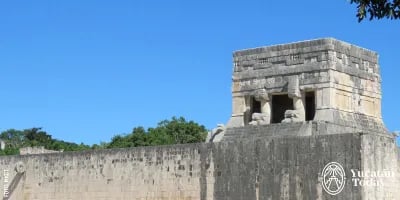
The Grand Ballgame Court
Taking in the reliefs at the sides of the Grand Ballgame Court alone might take a full hour. You’ll see all sorts of scenes represented, the most remarkable depicting warriors wearing the protections needed to participate in this ceremonial “game;” you’ll also see representations of decapitated players and the players that did the decapitating.
While not every instance of the Mesoamerican ballgame ended in human sacrifice, it’s important to pause here to talk about the practice, which, from a European (and now European-based) perspective would be/is considered “barbaric.” Even if we overlook the fact that most civilizations (and even the Judeo-Christian canon) include the concept of blood sacrifice to the god or gods, the Maya believed that the way people died determined which god would call them to which heaven. Prisoners of war, for example, were already destined to be sacrificed, but by dying after the glory of winning the ballgame, a different, more glorious god would favor them, allowing them to aspire to a better fate than if they had died any other way.
Back to the Grand Ballgame Court, perhaps its most remarkable aspect is precisely its grandeur: it’s the largest one in Mesoamérica. Archaeologists believe that, given its size (approximately 230 ft) and the height of the hoops, it was probably a symbolic court, that was only meant to represent the traditional Ballgame, and where the lords of Chichén and their guests of honor dressed up to portray the gods and mythical entities related to this activity, putting on a performance of legendary events, such as those narrated in the Popol Vuh.
Temple or Platform of the Eagles and Jaguars
This platform presents reliefs of, well, eagles and jaguars, whose claws hold human hearts in representation of the aforementioned sacrifices. On them, eagle and jaguar warriors, responsible for capturing prisoners, are depicted resting with their spears. Here it’s worth mentioning that, while jaguar and serpent warriors are common in Maya culture, eagle warriors are another feature that was “imported” from central México.
Notice how each of these platforms, which were used as ceremonial stages, serve four directions. This isn’t only a reference to the cardinal points, but also reinforces the four-sided government theory, in which four lineages took turns ruling the city; the stairs allowed each of them equal representation and participation in rituals.
Directions themselves had a symbolic charge: looking south wasn’t the same as looking north, east, or west. In Yucatán, the north is always associated with the sea; looking east is looking at where the sun rises; looking west, at darkness and death; and, in the case of Chichén Itzá, south is where all enemies came from, as well as imported items such as cacao, which wasn’t grown locally.
Venus Platform
We normally associate Venus with the goddess of beauty; get that image out of your head, because this platform represents Warrior Venus, a male god that opens the door and accompanies the sun when it comes back to life after conquering the underworld (so, at dawn).
We should note that Venus as a war god is not a Maya belief; it is also a belief from central Mexican civilizations, so this god is believed to be a Chichén (because it isn’t Maya) version of the Nahuatl god Tlahuizcalpantecuhtli (worry not, it’s pronounced exactly as it’s spelled).
On the central panel to the sides of the stairways you’ll see the figure of this god, represented coming out of a feathered jaguar’s mouth. At its sides, there are two easily recognizable symbols: on the left, a weaving or petate mat that represents the nobility ruling over the land that was given to them; on the right, the conch spiral symbol, representing the “star” of Venus.
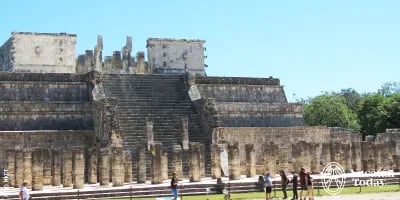
Temple of the Warriors
The Temple of the Warriors is unfortunately located basically behind El Castillo; if it weren’t, it would probably be one of Chichén Itzá’s most impressive constructions. It’s more complex than it appears, as inside it there is at least one substructure that was “sacrificed” and modified to create a new building, the one we can see today.
The first thing you’ll notice (the only thing, if you’re just breezing through) on the ground level are the square columns that represent great warriors from the most renowned lineages in the city’s history to that point; if you were anyone important back then, surely one of your ancestors would have been depicted there.
At the time of the city’s splendor, the figures that “guarded” this war-centered building would have been embedded with obsidian and seashell to bring out their eyes. The figures would appear to look sideways, so that when the select few people allowed to enter did, they’d feel the weight of these fierce warriors’ gaze.
The flat roof the columns bore would have comprised lines of lintels, and transversely, complete cane logs; it was covered with mortar, stones, and stucco, creating a lightweight roof that was faster and cheaper to build.
On the top level there’s plenty to see, so make sure to take your time and, if possible, use binoculars or a powerful zoom lens. Where the stairway ends you’ll see, on each side, the head of a feathered snake (Kukulkán); atop each, a sculpture of a standard-bearing monkey. Between them, a Chaac Mool (a man laying on his elbows, holding a plate); the two columns that would form the doorway are the most iconic representations of the feathered snake; you may have seen reproductions, either in Mérida, at the Parque de las Américas fountain in García Ginerés, or in Cancún, at the fountain where the hotel zone begins. On the walls, on each side, you’ll see more figures of Warrior Venus coming out of a feathered jaguar’s maw.
South of the Great Platform
The Ossuary
Between the Red House group and the Great Platform, you’ll find the Ossuary pyramid. It is reminiscent of El Castillo, in a smaller scale, and it is also flanked by a Venus platform, with the same layout. Inside there’s also a substructure and a round altar, similar to one found in Chichén Viejo (about which you’ll read later, if you’re still with us). The three top levels (of the nine that make up the Ossuary pyramid) display stone reliefs depicting warriors. At one of the pyramid’s corners, at the ground level, you’ll see a sort of totem of “Chaac” masks; it was restored and displayed there for convenience, as the masks were originally on top of the structure.
Why “Chaac” in quotation marks, you might ask? Or maybe, “who or what is a Chaac?” Chaac is the Maya rain god, usually depicted as having a hook nose. It is now known that Chaac isn’t the only Mesoamerican god that had a hook nose, and, Chichén stepping away so far from the Maya norm, it would be unlikely for Chaac to be found here. The representation could be Tláloc, the Aztec rain god, or Wits, the Maya god of the mountains, who, understandably, wasn’t too popular in Yucatán. Still, because in central México mountains were found everywhere, it is possible that the artificial mountains (pyramids) were built for him anyway.
The Ossuary also has a substructure within, a round altar similar to one found in Old Chichén (see below), and another Venus Platform; the layout is reminiscent of the one in the central esplanade, which suggests this might be a replica of the El Castillo area.
To the north: the Sacred Cenote
The Sacred Cenote
Five hundred meters north of El Castillo, a Sacbé (pre-Hispanic walkway) will take you to the Sacred Cenote. Shaped like an oval with a diameter that ranges between 50 and 60 meters, it is 13 meters deep. In it, evidence of several types of sacrifices has been found, from human and animal skeletons to pieces of ceramics and jewelry. Many of the material that was retrieved from it was originally smuggled to museums in the United States; part of it has been recovered and is displayed in the National Museum of Anthropology in México City, and will hopefully be brought back to Yucatán to be part of the new museum to open in Chichén Itzá in the coming months.
It isn’t possible to swim in the Chichén Itzá sacred cenote. Not only because it’s forbidden, but because it’s inaccessible: the water surface is 15 meters below ground level. In any case, the Sacred Cenote is one of the few in Yucatán where nobody would want to swim: because of its natural features, it’s full of microalgae that make the water look muddy and green, and not at all inviting.
The Observatory or Caracol
This structure has two names because one honors its function, and the other its construction. Inside, the building features a spiral staircase that led its users to the upper level. On the outside, it would have had the shape of a wedding cake. On the upper level, slots or windows on the circular wall allowed astronomers to study and document celestial bodies and their trajectories within their assigned field of vision.
In front of the Observatory, on the retaining wall where the last of the visible staircases culminates, you’ll see some stone cylinders. If you have a good lens, don’t forget to take a close look: they are sculptures of heads.
The Nunnery Complex and The Church
At the southern end of the main site, you will find this complex, which will surely captivate you due to its distinct appearance. Much more square in style (not pyramidal) and ornamental, it is more similar, for example, to Uxmal (hundreds of kilometers away) than the rest of Chichén Itzá. If you are interested in appreciating up close the details of reliefs, engravings, sculptures, and stucco work that was done in Chichén over the centuries, you’ll find that the 500-meter walk from El Castillo is well worth it.
Old Chichén: Chichén Viejo
As mentioned above, the ritual area of Chichén Itzá (where El Castillo, the Observatory, etc., are) is one of the most “modern” areas in the Mexican Maya world. Chichén Viejo, however, is true to its name.
As we mentioned above, this part of the site, which remained closed to the public for decades, is a housing area for one of the elites that took turns ruling the city; you’ll see flatter, longer buildings, more similar to those in Uxmal than in Chichén Itzá. Another important difference with the rest of the site is the atmosphere. Access to this area is still very limited, so the silence is only broken by the sounds of the wind in the trees, the birdsongs, and, if you’re visiting on Friday, the sounds associated with the work carried out by the National Institute of Anthropology and History (INAH) personnel.
How to visit the Initial Series at Old Chichén (Chichén Viejo)
The part of Chichén Viejo that is open to visitors is known as the Group of the Initial Series, referencing a stone engraving of a long-count calendar date found there. Since its opening in September 2023, access is controlled, since there are no services available (restrooms, walkways, etc.), and, at least for now, the area could not handle the huge load of visitors that arrive in Chichén Itzá every day.
There is no additional fee to visit Chichén Viejo; admission is included with your access to the archaeological site (see fees here). However, this part of the site is only open to visitors twice a week (Fridays and Saturdays) in two time slots: 9 am and 12 pm. At each time slot, only 25 people are allowed access, for a total of 100 visitors a week. To secure your spot, you can reserve in advance (by calling Tel. 985 851 0137), but if you’re at the site on a Friday or Saturday morning, there’s no harm in asking whether there are places available.
Visiting Old Chichén
Your visit to Chichén Viejo includes a three-quarter-mile hike (about 1.2 kilometers) over a recently opened trail. There are plans to turn this into an eco-archaeological trail with resting and wildlife-watching areas, but, for now, it is important to note that this is a rustic trail with no services that should take about 25 minutes to walk.
Temples of the Sunrise and Dusk
Once you’re at the site and have gone through the arch that marks the entrance, the first structures you’ll find are the Temples of Sunrise and Dusk, which, of course, function as solar markers. Between them you’ll see the Temple of Platform of the Turtle, which references the legend of the birth of Hun Hunahpú, the god of corn, to whom this part of the complex is dedicated.
The Temple of Dusk, also known as The Tomb, is associated with darkness and death; as a matter of fact, inside it, the burned remains of several young men and women dressed as warrior were found inside. On the other end, the Temple of Sunrise is the only pyramid in the area. It is also the one that gives the group its name: a stone lintel is engraved with the only full long-count calendar initial series found in the area to date, corresponding to July 13, 878 CE. This structure is built on an earlier substructure, which helps us date the settling of Chichén in approximately 600 CE.
The House of the Moon
The House of the Moon was a place of worship; as you pass through the columns, pay attention, especially to their bases; you might be able to distinguish some remnants of paint. The floor and the stone baseboard were black, followed by a red band and a yellow one, simulating a sunset. At the back, there is an altar where evidence of ritual fire was found. Archaeologists currently believe that this was the site of an initiation ritual involving self-sacrifice.
House of the Snails and House of the Phalluses
This seemingly huge construction is actually two buildings that ended up merging into one. Both face a common courtyard (called the Courtyard of the Bird Men) where you will see countless columns depicting warriors standing on a base showing the representation of the Warrior Venus (god of war), who, as mentioned before, accompanies the sun when it emerges from the underworld.
The figures that give their name to these structures are in the friezes of the walls; from bottom to top, first, you will see the phalluses; just above them, a first row of snails, which appear to look in one direction, and higher up, above a series of reliefs, the second row of snails, looking the opposite way.
You’ll probably exit the structure passing by two columns in the shape of warriors (commonly called Atlantes, even though they have nothing to do with Atlas); pay attention to the frieze above them, and see if you can spot the “branches” coming out of the central character, another allusion to the importance of lineages in this area.
House of the Shields
This is one of the most recently identified structures, which does not mean it was recently discovered: archaeologists knew it existed, but didn’t know what it was. It was believed to be a later addition to the House of the Snails, but when the façades were excavated, the south wall was discovered to have displayed stone engravings of war emblems. Seven of the emblems were found, each of them made up of between six and eight panels. This more recent excavation was carried out by archaeologists Max Ayala and Arturo Cortés.
One of them (which was facing the southeast) had remains of paint, and is currently being analyzed to determine what the emblems would have looked like in color. The emblems are round, adorned with might be feathers; there are more, longer feathers at the bottom as ornamental garlands. Across the shield you can see three arrows, the heads facing one way and the fletchings or darts the other. You can also see a dart thrower, which was part of the warriors’ equipment and, depending on the emblem, a sort of club or blunt weapon. To the side, there is a bag; its contents aren’t known, but theorized to be either arrowheads or ritual objects. These elements are all commonly seen in panels depicting warriors, who usually carrying the same bag, arrows in one hand, darts in the other, a shield on the forearm.
House of the Owls
This structure, south of the House of Snails square, is named after the owls that decorate it inside and out. Owls with their wings spread out can be seen on the friezes on all four sides of the building; above and below them, there are lines of turtles. There are also representations of owls on the columns, but here they’re accompanied by the weaving that represents the nobility, as well as cacao trees; both cacao trees and owls are associated with the south, not only by the Maya, but also by pre-Hispanic civilizations that settled what today are the Mexican states of Oaxaca and Veracruz.
House of the Monkeys
The House of the Monkeys is very similar to the House of the Snails, both in length and in the reliefs you’ll see on it. However, here you’ll also find the representation of a ruler whose name might be 10-Dog or 10-Coyote; we might as well call him 10-Canid. In addition to plants and fruits, you’ll also see, on all four sides of the building, representations of monkeys squatting as if they were, well, pooping, presumably to spread seeds around.
The equinox at Chichén Itzá
Chichén Itzá is especially famous for the play of light and shadow that occurs during each equinox. In both March (spring equinox) and September (fall equinox), you can observe that the shadow of the nine platforms of El Castillo or Kukulkán Pyramid is projected onto the balustrades of the staircases, forming seven triangles of light. As the sun descends toward the horizon, the triangles, combined with the sculptures at the base of the stairs, give the impression of a serpent descending from El Castillo.
This phenomenon is most pronounced around the 21 of both March and September, and to a lesser extent, a few days before and after. Observing this phenomenon is free, but especially on the actual day, the site is even more crowded with visitors; try to arrive early to secure a good spot and protect yourself from the sun.
Today’s Tip:
If it’s cloudy, the archaeological-astronomical phenomenon of the equinox may not be as clearly distinguishable. March is the driest month of the year in Yucatán; however, September is still within the rainy season.
For more details about the equinox at Chichén Itzá, read “The Maya: The Equinox and the Solstice“.
The Video Mapping at Chichén Itzá: Noches de Kukulkán
Chichén Itzá offers a video mapping show (light and sound) projected onto El Castillo, exclusively in Spanish. “Noches de Kukulkán” takes you on a journey through Maya cosmogony, creating optical illusions that will surely amaze you. The show lasts approximately 25 minutes.
Before the video mapping, you will have the opportunity to explore the main structures of the central esplanade (the Great Ball Court, the Platforms, and the Temple of the Warriors), illuminated in different colors; this creates a completely different experience, in peace and silence.
Tue. – Sun. 7 pm (winter season) and 8 pm (spring and summer)
Tickets at the box office or through the website: www.nochesdekukulkan.com.mx
Would you like to learn about other video mappings in Yucatán? Click here to read “Nights of Light and Sound in Yucatán“.
Nearby Activities
Chichén Itzá is essentially located in the center of the state, making it easy to travel to and from various other points of interest.
Distances
- Distance between Chichén Itzá and Pisté: 3 km, or almost 2 miles (8 minutes by car)
- Distance between Chichén Itzá and Kaua: 20 km, or 12 miles (20 minutes by car)
- Distance between Chichén Itzá and Valladolid: 44 km, or 27 miles on the free road (46 minutes by car)
- Distance between Chichén Itzá and Espita: 51 km, or 31 miles (58 minutes by car)
- Distance between Chichén Itzá and Izamal: 73 km, or 45 miles on the free or toll road (1:15 hours by car)
- Distance between Chichén Itzá and Mérida: 122 km, or 75 miles (1:45 hours by car)
- Distance between Chichén Itzá and Cancún: 205 km, or 127 miles (2:30 hours by car)
- Distance between Chichén Itzá and Playa del Carmen: 182 km, or 113 miles (2:15 hours by car)
- Distance between Chichén Itzá and Tulum: 154 km, or 95 miles (2:10 hours by car)
- Distance between Chichén Itzá and Uxmal: 197 km, or 122 miles (2:26 hours by car)
- Distance between Chichén Itzá and Tekax: 123 km, or 76 miles on secondary roads (2:13 hours by car
Where to Eat Near Chichén Itzá
The closest options are Pisté (where hotels offer various dish options, either buffet or à la carte) and Kaua (where there are several restaurants and traditional kitchens, specializing mainly in Poc Chuc and Valladolid sausage).
In Valladolid, the self-proclaimed gastronomic capital of Yucatán, you will find many cultural activities, refreshing cenotes, and a wide range of gastronomic options.
In Espita, hotels like Casona Los Cedros and Casa K’acaya offer Yucatecan food options with a gourmet touch.
Where to Stay
Chichén Itzá has a hotel zone, both around the site and in Pisté, but you can also choose to stay in one of the nearby Magical Towns, such as Valladolid, Espita, or even Izamal.
Pisté
Hacienda Chichén
Carretera Libre #180, Km 120
Tel. 999 920 8408
The Lodge at Chichen Itzá
www.mayaland.com
We thank the team of the Chichén Itzá Project, led by Archaeologist José Osorio, for the facilities provided for the completion of this article. We extend our gratitude to Archaeologist Arturo Cortés for his support in verifying the presented data, and to Archaeologists Francisco Pérez, Claudia Ochoa, Julio Alonso, and Miguel Salazar for their cooperation.

Riding a Colectivo in Mérida: A Local Adventure Worth Taking
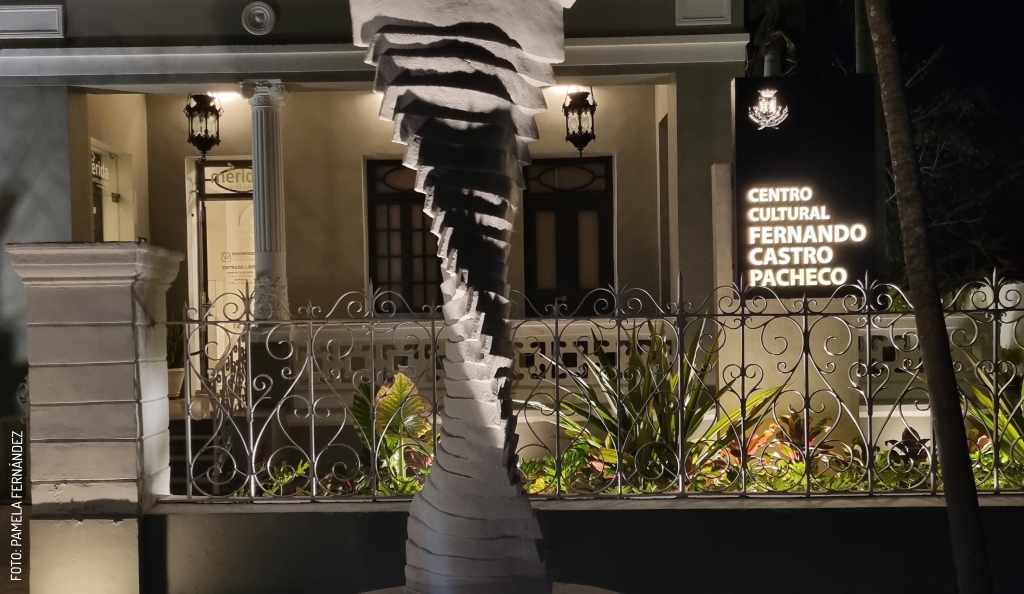
A Seven Day Stay: Telchaquillo, Teabo, Valladolid, Cenotillo
